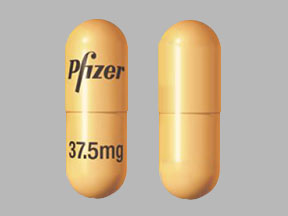Sutent Dosage
Generic name: SUNITINIB MALATE 12.5mg
Dosage form: capsule
Drug classes: Multikinase inhibitors, VEGF/VEGFR inhibitors
Medically reviewed by Drugs.com. Last updated on Mar 25, 2025.
Recommended Dosage for GIST and Advanced RCC
The recommended dosage of SUTENT for gastrointestinal stromal tumor (GIST) and advanced renal cell carcinoma (RCC) is 50 mg taken orally once daily, on a schedule of 4 weeks on treatment followed by 2 weeks off (Schedule 4/2) until disease progression or unacceptable toxicity. SUTENT may be taken with or without food.
Recommended Dosage for Adjuvant Treatment of RCC
The recommended dosage of SUTENT for the adjuvant treatment of RCC is 50 mg taken orally once daily, on a schedule of 4 weeks on treatment followed by 2 weeks off (Schedule 4/2), for nine 6-week cycles. SUTENT may be taken with or without food.
Recommended Dosage for pNET
The recommended dosage of SUTENT for pancreatic neuroendocrine tumors (pNET) is 37.5 mg taken orally once daily until disease progression or unacceptable toxicity. SUTENT may be taken with or without food.
Dosage Modifications for Adverse Reactions
To manage adverse reactions, the recommended dosage modifications are provided in Table 1. Table 2 provides the recommended dosage reductions of SUTENT for adverse reactions.
| Indications | GIST | RCC | pNET | |
|---|---|---|---|---|
| Advanced RCC | Adjuvant RCC | |||
|
First dose reduction |
37.5 mg once daily |
37.5 mg once daily |
37.5 mg once daily |
25 mg once daily |
|
Second dose reduction |
25 mg once daily |
25 mg once daily |
NA |
NA |
| Adverse Reaction | Severity | Dosage Modifications for SUTENT |
|---|---|---|
|
Hepatotoxicity |
Grade 3 |
|
|
Grade 4 |
|
|
|
Cardiovascular events |
Asymptomatic cardiomyopathy (left ventricular ejection fraction greater than 20% but less than 50% below baseline or below the lower limit of normal if baseline was not obtained) |
|
|
Clinically manifested congestive heart failure (CHF) |
|
|
|
Hypertension |
Grade 3 |
|
|
Grade 4 |
|
|
|
Hemorrhagic events |
Grade 3 or 4 |
|
|
Thrombotic microangiopathy |
Any Grade |
|
|
Proteinuria or Nephrotic syndrome |
3 or more grams proteinuria in 24 hours in the absence of nephrotic syndrome |
|
|
Nephrotic syndrome or recurrent proteinuria of 3 or more grams per 24 hours despite dose reductions |
|
|
|
Dermatological toxicities Erythema multiforme (EM), Stevens-Johnson syndrome (SJS), toxic epidermal necrolysis (TEN), Necrotizing fasciitis |
Any Grade |
|
|
Reversible posterior leukoencephalopathy syndrome |
Any Grade |
|
|
Osteonecrosis of the jaw |
Any Grade |
|
|
Impaired wound healing |
Any Grade |
|
Dosage Modification for Drug Interactions
Strong CYP3A4 Inhibitors
Select an alternate concomitant medication with no or minimal enzyme inhibition potential. If coadministration of SUTENT with a strong CYP3A4 inhibitor cannot be avoided, consider a dose reduction for SUTENT to a minimum dosage as follows:
- •
- GIST and RCC: 37.5 mg orally once daily, on a schedule of 4 weeks on treatment followed by 2 weeks off (Schedule 4/2)
- •
- pNET: 25 mg orally once daily
Strong CYP3A4 Inducers
Select an alternate concomitant medication with no or minimal enzyme induction potential. If coadministration of SUTENT with a strong CYP3A4 inducer cannot be avoided, consider a dose increase for SUTENT to a maximum dosage as follows:
- •
- GIST and RCC: 87.5 mg orally once daily, on a schedule of 4 weeks on treatment followed by 2 weeks off (Schedule 4/2)
- •
- pNET: 62.5 mg orally once daily
If the dose of SUTENT is increased, monitor patients carefully for adverse reactions.
Dosage Modification for End-Stage Renal Disease Patients on Hemodialysis
No starting dose adjustment is required in patients with end-stage renal disease (ESRD) on hemodialysis. However, given the decreased exposure compared to patients with normal renal function, subsequent doses may be increased gradually up to 2-fold based on safety and tolerability.
Frequently asked questions
- Does Sutent shrink tumors?
- Is Sutent considered a chemotherapy drug?
- How long do you take Sutent before it starts to work?
- Is Sutent effective for kidney cancer?
More about Sutent (sunitinib)
- Check interactions
- Compare alternatives
- Pricing & coupons
- Reviews (30)
- Drug images
- Side effects
- Patient tips
- During pregnancy
- Generic availability
- FDA approval history
- Drug class: multikinase inhibitors
- Breastfeeding
- En español
Patient resources
Professional resources
Related treatment guides
See also:
Further information
Always consult your healthcare provider to ensure the information displayed on this page applies to your personal circumstances.


